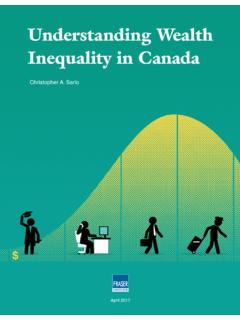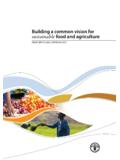Transcription of Tool Name: Wealth (Well-Being) Ranking - World Bank
1 tool name : Wealth ( well -Being) Ranking What is it? This tool is a method for collecting and analyzing data on perceptions of Wealth differences and inequalities in a community and for identifying and understanding local indicators and criteria of Wealth , well -being, and poverty. What can it be used understanding socioeconomic differences within communities for? understanding local perceptions of and criteria for Wealth , well -being, and inequality in a community categorizing households or social groups into different locally perceived economic or more general well -being categories exploring differences in how different people have access to and use resources identifying target group members before a project, program, or policy is changed or implemented, or to determine the extent to which targeting has proved successful after the event What does it tell local concepts of Wealth , economic, and well -being status you?
2 Economic and well -being profile of a community social stratification at the community level ownership of or use rights to productive assets Complementary Social mapping tools Key elements This participatory data generating process uses locally defined criteria for Wealth / well - being. Requirements Data/information This tool generates data and information; the only prior information required is for identifying the sampling frame within the community. Time The time is depends on size of the community and the number of households or individuals being ranked. Skills Good participatory facilitation skills and social analytical skills Supporting No software needed software Financial cost This tool will cost $30,000 to $100,000 when conducted as part of a participatory study, depending on the number of communities sampled and the geographical scope of the study.
3 Limitations Wealth Ranking gives a static picture and does not easily convey poverty dynamics. A narrow focus on Ranking households does not address the distribution of well -being within households (such as by gender or age). Wealth Ranking might be a sensitive issue and some might see a participatory or public exercise as overly intrusive. References and FAO. The Forest Manager's Guide to Participatory Forest Management: Module 3. applications The Participatory Process in Forest Management. Forestry Policy and Institutions Branch, Forestry Department. Jeffries, D., H. Warburton, K. Oppong-Nkrumah, and E. Fredua Antoh. Wealth Ranking Study of Villages in Peri-urban Areas of Kumasi, Ghana. Collaborative project between the Social and Economic Development Department, Natural Resources Institute and the Statistical Services Centre, The University of Reading.
4 Pakistan Government, Planning Commission. 2004. Between Hope and Despair.. Pakistan Participatory Poverty Assessment Sindh and Punjab Reports. Rock, F., ed. 2001. Participatory Land Use Planning (PLUP) in Rural Cambodia, Annex 11. Ministry of Land Management, Urban Planning and Construction 1. (MLMUPC), Cambodia. DFF1/$ Sontheimer, S. et al. 1999. Conducting a PRA Training and Modifying PRA Tools to Your Needs. An Example from a Participatory Household Food Security and Nutrition Project in Ethiopia. 2. Wealth ( well -Being) Ranking : Procedures and Examples Time, Materials, and Skills Needed About one hour should be allowed to conduct a Wealth - Ranking exercise and to ensure that a full discussion occurs with local analysts.
5 Markers/pens and are a large number of cards are required. Notebooks/paper and pens are needed for the note-taker to record the discussion generated during the Ranking . The discussion group will include a facilitator, observer/note-taker, and selected local analysts. The facilitator and observer/note-taker should be experienced in both the principles behind the use of participatory tools and methods as well as in their practical use. Knowledge of the social structure of the community is required by the facilitator because community members might consider Wealth or poverty to be sensitive issues, which might affect the discussion and analysis. If local analysts or community members are uncomfortable with discussing the exercise, the facilitator should try other methods of investigating local criteria and concepts of well -being that do not involve Ranking individual households.
6 Possible Approach The following approach is a general example that can be adapted to suit the local context, views of local analysts, and the research objectives. If a social map has not been produced, then a method using cards can be used; an alternative that might be more suitable in some circumstances is to move straight from social mapping into a Wealth Ranking (both approaches are described below). Step 1: Select Local Analysts. Identify the groups of people to talk to about their perceptions of Wealth criteria and Ranking . These decisions will be based on the objectives and depth of information required for the research. For example, separate gender groups might be useful because women and men might have different criteria for determining Wealth or well -being status.
7 However, it might be necessary to break down the population into further categories (such as by ethnicity, age, livelihood group, or caste). Groups of five to ten local analysts should reflect any relevant and important social divisions. The information they provide will also allow some cross-checking with different groups at different locations. Step 2: Provide Introductions and Explanations. When working with each group, the facilitator and observer/note-taker should begin by introducing themselves and explaining carefully and clearly the objectives of the discussion. Issues surrounding Wealth might be sensitive subjects for local analysts; check that they understand and feel comfortable with what will be discussed.
8 Step 3: Produce a Wealth Ranking A. Without a social map: Ask the local analysts to write the names of all the households living in the community on a card (one name per card) together with any other information that might be significant to a particular enquiry. An official list of all the households in the community might be available; if it is used, make sure that it is double-checked by local analysts because official lists or registers might be incomplete or out of date. (In cases where discretion and confidentiality are required, it is possible to assign a number to each 3. household so that after the analysts have grouped households into different categories, the household can be referred to by a number rather than by a name .)
9 In a large community, where a small group of analysts from one location cannot be expected to retain accurate information about the situation of all the other households, the cards can be divided into smaller groups. Ask the analysts to discuss the criteria that they use in distinguishing between the better and less well -off members of their community. What makes them think that a household is better off or less well -off? Next, ask them to sort the cards in to as many piles as there are Wealth categories in the community (using their own criteria), resorting as they go, if necessary. This will usually lead to the cards being sorted into about four or five categories. If, however, the number of categories is smaller, it might be appropriate to ask if any piles could be further subdivided.
10 When the process is complete, ask the analysts to take each pile in turn and explain the broad characteristics held in common by the households falling within it. Also ask about the differences in criteria between piles. Some further resorting might take place in the light of the criteria expressed. If, for the purposes of the investigation, it is important to distinguish between different levels within the target group but the given categories do not fully meet these requirements, it might be appropriate to ask for some more resorting at this stage. It is generally easy to resolve this difficulty when it arises. The final step is to record the category of each household at the bottom of the card.















